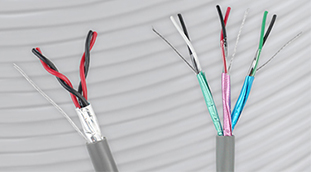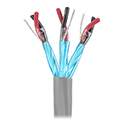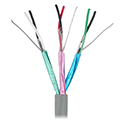Categories
- Wire & Cable
- Multi-conductor & Signal Cable
- Battery Cable Assemblies
- Terminals and Connectors
- Electrical Parts
- Electrical Tools
- ID Products
- Wire Management
- Tape & Sealant
- Mounting Panels & Panel Blanks

Need Help?
Click HereGet a Business Account
Apply HereMulti Pair and Tray Cable


What are multi-pair cables?
Multi-pair cables are a type of electrical cable that consists of groups of insulated conductors. These conductors are twisted into pairs before being jacketed together in the same form as multi conductor cables. Some cables have each pair shielded, while other Multi-pair cables have an overall shield or no shield at all. Multi-pair cables are commonly popular for many of the same reasons as multi conductor cables. That is, the ability to run several wires in one convenient package. This makes wiring installation a simpler task. This type of cable is utilized by the communication and computer industries.
What are tray cables?
Tray cables are two or more insulated conductors for installation in trays or similar channels. They are made with or without grounding conductors beneath a non-metallic sheath. Basically, they are run across wireways, ducts, or trays, usually along the ceiling, in hazardous environments. Oftentimes, in industrial areas, there is a multitude of cables to be run across a location. Rather than running them across the floor where they would be susceptible to damage, the cables are placed in trays. These elevated trays offer long-term protection of both the cables themselves and the transmitted signals.
How do I strip multi-pair tray cables without damaging the internal conductors?
To properly strip multi-pair tray cables, you'll need three tools: a cable cutter, a round cable stripping tool, and a compact wire stripper. Start by measuring the cable, adding an extra inch or two. The high-leverage cable cutter will cut through multi-pair tray cable with ease, eliminating damage to the internal conductors. Now using the round cable slit tool, adjust the blade to the proper depth. Make several full passes around the cable and pull the outer jacket off, revealing the internal pairs. After removing the foil shield, use the compact wire stripper. This tool offers multiple crimp nests to handle a wide range of wire sizes. After figuring out the correct amount of insulation to strip, use the strippers to cut the insulation, pulling it away from the main section to expose the internal conductors. All that is left is to repeat the process on the remaining conductors.
Where would I use these cables?
Multi-pair and tray cables are used in the communication industry, the computer industry, and in industrial settings. In environments where electromagnetic interference (EMI) is an issue, multi-pair and tray cables are an effective choice as their shielding is designed to help prevent signal interruption. Additionally, these types of cables are designed with harsh environments in mind, meaning that their outer insulating jacket is durable and built for longevity.
"In environments where electromagnetic interference (EMI) is an issue, multi-pair and tray cables are an effective choice as their shielding is designed to help prevent signal interruption."
How beneficial is shielding?
Shielding is absolutely essential in areas where EMI is an issue. While even unshielded cables offer some level of protection from EMI, you’re likely to deal with signal interruption and other issues when not using a cable that offers shielding. Multi-pair and tray cables carry internal conductors, where the signal is carried, and outer shields that block outside interference. In this way, your signal is restricted to the space inside the shield, and as a result, signal loss is greatly reduced. The shielding comes in several forms, each designed to handle specific power needs in relation to EMI. Below we will look at some of the types of shielding offered on these cables.

What does individually shielded mean?
![]()
The term individually shielded refers to the idea that each pair of conductors is wrapped in a foil shield independently from the other pair. This helps to prevent any interference between the pairs themselves, which is commonly called “cross-talk”. In this way, your signals are protected from internalized and externalized interference, making this type of cable the best choice in situations where you need to transmit data at high speeds with little distortion. Another thing to consider is that there are two types of individually shielded. One where each pair carries the same type of foil and one where the foil on each pair is different. We will discuss this idea further down.
What does overall shielding mean?
![]()
Overall shielding refers to the idea where the internal twisted pairs of wires are not individually shielded but instead wrapped altogether under one continuous shield. This shield prevents external noise and reduces overall signal interference. The overall shield creates a barrier where the signal is restricted to the interior of the shield, where the conductors are, and the interference is mostly blocked, meaning that your signal can continue to hold and transmit without interruption. Often, these types of cables are used in POS (point-of-sale) equipment as well as in control circuits where total signal isolation is needed.
What are the specific differences between these cables?
1. Power Limited Tray Cable, Individually Shielded Pairs, 2 Pairs
This type of cable has two pairs of twisted wires, each with a drain wire. Each set is individually wrapped in a foil shield to prevent crosstalk and electromagnetic interference. These are commonly used in burglar alarms, power-limited circuits, intercom systems, and computer interconnects.
2. Power Limited Tray Cable, Individually Shielded Pairs, 3 Pairs
This cable is basically the exact same as the one above, although instead of two pairs of twisted wires with a drain, this cable has three pairs. Again, each pair is individually wrapped in a foil shield.
3. Multi-Pair Individually Shielded
Multi-pair, individually shielded cable has two distinct pairs of twisted wires. One pair is for power, the other for data. Additionally, this type of cable only carries a single drain wire as opposed to the ones above. This type of cable is used in computers, industrial equipment, and control circuits where signal isolation is necessary.
4. Multi-Pair Individually Shielded, No Overall Shield
This type of multi pair cable has three individually shielded pairs, each with a different type of foil shielding. They do not carry an overall shield but rather three different, unique shields meant to protect each twisted pair in different ways. This type of cable is used in remote control circuits as well as industrial equipment control circuits.
Multi-pair overall shield has one continuous shield that surrounds both pairs of twisted wires and carries a single drain wire. Unlike the other cable on this list, this is the only one where the pairs themselves are not individually wrapped. This is due to the fact that the internal wire pairs do not need to be protected from internal crosstalk. This type of cable is commonly used in POS (point-of-sale) equipment, control circuits, and a host of other commercial and industrial applications.
What compliances do these cables meet?
These cables are designed to meet or exceed a host of compliances in order to give the highest level of quality and dependability available. As each cable is very different from the next, the compliances they meet are quite different as well. Below you will see a list of the individual cables and the compliances that they meet.
1. Power Limited Tray Cable - Individually Shielded Pairs, 2 Pairs/3 Pairs
2. Multi-Pair Individually Shielded
3. Multi-Pair Individually Shielded, No Overall Shield
What industries use multi-pair tray cables?
A wide range of industries utilize multi-pair tray cables in their everyday activities. They are chosen for their high level of durability as well as their longevity in tough industrial conditions. You will find these types of cables in applications such as computer logistics, intercom communications, industrial control equipment, burglar alarms, power-limited circuits, data transmission, and control circuits. You can see just how useful these cables are with the wide range of applications where they are utilized.
Why use these over other, similar cables?
Other, similar cables may claim to offer the same level of protection from the environment and electromagnetic interference as Pacer's multi-pair and tray cables, but do they meet or exceed the same number and types of compliances? The bottom line is that you want quality. Quality that comes from experience. The experience we have after over forty years in the marine industry. We trust these cables so much; they are the ones we use. When you see the name “Pacer," you know you have quality.
*This page was updated on 1/30/2025*










